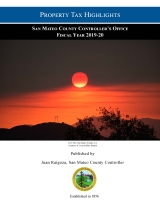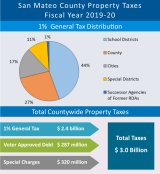
Redwood City – Property taxes grew for the ninth consecutive year in Fiscal Year (FY) 2019-20 — by a total of $225 million or 8 percent more than the prior year — contributing to $3 billion to be distributed county-wide to local government agencies that provide essential services to the county’s residents, according to the Property Tax Highlights report released today.
The annual report released by the San Mateo County Controller’s Office provides the public with details about the amount of property taxes distributed to the 131 local governments operating within San Mateo County, including the cities, school districts, special districts and the County.
“It’s important to me that we provide taxpayers and residents visibility into the tax dollars they pay and where those dollars go,” said County Controller Juan Raigoza.
The tax growth is primarily due to annual increases in assessed property values resulting from real estate sales and new construction.
Total county-wide assessed values and taxes have increased 6 to 8 percent each year from FY 2013-14 to FY 2019-20. Total values and General Taxes will grow 7 percent in the current fiscal year (FY 2020-21).

For the next year, total property values as of January 1, 2021, used for FY 2021-22 and for installment tax bills due in December 2021 and April 2022, are expected to grow but not as much as in recent years.
The year-over-year vacancy rate of office commercial properties in the county increased from 7.6 percent to 11 percent as of the fourth quarter of 2020, while the asking lease price per square foot has remained relatively flat for the year.
Conversely, the residential real estate market continues to show some strength. During the 12 months ending February 2021, prices of single-family homes have increased, while those of condominiums have remained relatively flat.
In general, the pandemic has reduced demand for office space due to more workers teleworking, which may weaken growth in future assessed values of those properties. On a positive note, the life sciences industry continues to generate demand for office and research and development space.
The top 10 corporate taxpayers for FY 2019-20 accounted for 6.5 percent, or $174.7 million, of the total property taxes billed, up from 6.3 percent in FY 2018-19.
“This shows that the county’s property tax base is broad and does not rely on a few taxpayers or industries,” said Raigoza. “The county’s diversified local economy, skilled workforce, and desirable location for both residents and businesses should enable it to do well when the economy recovers in 2021 as more people in the county, state, country and world are vaccinated against COVID-19.”
As detailed in the report, the graph above shows the annual tax levy to property owners for the past 5 fiscal years. Over the 4-year period, from FY 2015-16 to FY 2019-20, the county-wide tax levy increased by $771 million (34 percent), due to increases in the 1 percent General Tax ($612 million), Debt Service ($79 million), and Special Charges ($80 million).

Under Proposition 13, the General Tax rate is always 1 percent. The increase in General Tax revenues resulted from annual growth in assessed values. County-wide, in FY 2019-20, the 1-percent General Tax totaled $2.4 billion, of which 44 percent went to schools, 27 percent to the County, 17 percent to cities, 11 percent to special districts, and 1 percent to former redevelopment agencies.
A total of $287 million of taxes for voter-approved debt (debt service) and $320 million for special charges were also levied in FY 2019-20.
The increase to debt service was primarily due to additional voter-approved school bonds, that make up most of the taxes collected for debt service, which are used to fund school building and maintenance projects.
Special charges primarily grew due to increases in sewer charges imposed by various cities. Special charges for services such as sewer, storm drainage, flood control, fire, improvements, maintenance, garbage, weed abatement, police, library, and parcel taxes are collected by the County for cities (60 percent of total charges), special districts (24 percent), and school districts (16 percent).
The report also provides an overview of property tax administration roles and responsibilities. The Assessor’s Office administers changes in ownership to properties and calculates the annual assessed values of properties, the Controller’s Office calculates tax rates and distributes tax revenues to local agencies, and the Tax Collector’s Office issues tax bills and collects taxes.
The report can be downloaded at: https://www.smcgov.org/controller/2020-highlights
Other County financial information, including the Comprehensive Annual Financial Report and Financial Highlights Report, is available at www.smcgov.org/controller.
controller@smcgov.org or (650) 363-4777